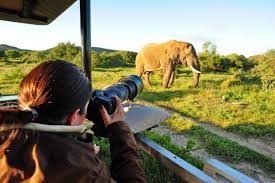
Five Simple Tips to Improve Your Safari Photographs
Five Simple Tips to Improve Your Safari Photographs. You will never forget going on safari in Africa, and epic safari photos will make sure that you can share the amazing experience with your family and friends. In fact, one of the best ways to share your trip with the people you care about is through the pictures you take. With that in mind, you should make sure you can take the best shots possible.
Here, travel blogger and photographer Josh from the Wanderlust Travel and Photos Blog dives into some of the best tips and tricks that he has learned during many years of landscape and wildlife photography. Josh says, “If you follow these tips, I promise you that you will be able to take some amazing pictures that you will cherish forever.”
1. How to Take Pictures on Safari:
Having the Right Camera Gear
One of the best ways to improve your safari photographs is to make sure you have the right camera equipment with you. You will be in a car for a lot of the safari, but you will also be able to take pictures of animals while they are loose. This makes taking pictures on safari very different from other times you might take pictures.
Bringing the right gear with you will make you feel better, protect your camera, and help you take more interesting pictures. To learn more about what kinds of camera gear I think you should bring on safari, click here.
2. When you have a fast shutter speed, use shutter priority.
This step is very, very important. Make sure your camera is in “Shutter Priority” mode unless you want to take a picture of something that won’t move, like a scenery. You should make sure that your camera is set to “Action Shot” or something similar if it doesn’t have a Shutter Priority mode. If you do this, the animals you are photographing will be free to move around. If you don’t change this setting, the pictures that you take will wind up blurry.
When your camera is in Shutter Priority mode, you can choose the shutter speed you want to use. Then your camera chooses which aperture to use to get the best exposure. If you want to learn more about shutter speed and aperture, check out my article on how to take pictures when there isn’t much light.
Basically, you can stop moving animals in photos by changing the shutter speed, which is how fast your camera takes pictures. You may need to change the camera speed to get the shot, depending on the animal and what it is doing. For instance, if I am taking a buffalo that is sitting still and grazing, I can safely use a shutter speed between 1/50 and 1/320 of a second and not have any motion blur. But if I want to take a picture of a cheetah running, I will need a shutter speed that is much faster, between 1/1000 and 1/1250 of a second.
3. For the best safari pictures, use the Rule of Thirds.
One of the best tips for framing the pictures that you take is to use the Rule of Thirds. This is a great picture-taking tip that can come in handy when you’re on vacation and taking pictures of animals. Try putting the animals to the left or right of center in some of your shots instead of in the middle of the frame where they always seem to be. By following this rule, you will create shots that are much more interesting to the eye.
We saw the same elephant twice while on tour in Tanzania’s Lake Manyara National Park. I’ve shown you two of them below. The elephant is in the middle of the frame in the picture on the left. Following the Rule of Thirds, I put the elephant in the right third of my shot on the right. Please decide for yourself which of the two pictures looks better.
4. Look at the eyes.
I hope this is the only tip you learn from this article. When you’re taking pictures of wildlife, the most important thing to remember is to always look into their eyes. When you see an animal, don’t just start taking pictures right away. Wait for the animal to look at you first. Next, make sure you look at their eyes.
Focusing on the eyes of the animal makes the viewer think that the animal is looking right at them through the picture. This will make pictures of animals looking at you much more interesting than pictures of animals looking away. This is especially important if you are taking a close-up shot of an animal. This is what I did with this picture of a Serengeti National Park lioness. Focusing on the eyes of the animals is the best way to make your safari photos stand out. It takes some practice, but it’s worth it.
5. Be ready with your camera at all times.
The last safari photography tip that I have for you is to always keep your camera ready while on safari. You never know what animals will be around the next turn, or what you might see over the next ridge while on safari. If you don’t have your camera ready, you might miss a wildlife photography shot of a lifetime. I was only able to capture this cute photo of two dik-diks in the Serengeti looking at me because I had my camera ready when we saw them. After a short time, they were off and running.








